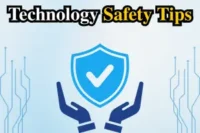Technology Safety Tips for a Secure Digital Life
Published: 14/Oct/2025
In today’s digital world, technology is part of almost everything we do — from checking emails to managing finances or staying in touch with loved ones. But with this constant use comes the risk of cyber threats like hacking, scams, and identity theft. The good news is that by following some simple technology safety tips, you can easily protect yourself, your personal information, and your family from potential harm.
In this article, we’ll cover the most important technology safety tips, explain why they matter, and provide practical steps that you can implement right away. So, let’s dive in!
Why Technology Safety is Crucial in 2025
With the rise of cybercrime, it’s more important than ever to stay on top of technology safety. Experts predict that by 2025, cybercrime could cause global losses of nearly $10.5 trillion every year. This huge number shows just how important it is to protect your personal data and digital devices.
Whether you’re a teenager on social media, a professional working from home, or a parent concerned about your child’s online safety, technology safety is something everyone must take seriously.
13 Essential Technology Safety Tips
Let’s explore some easy technology safety tips that will help you protect yourself and your loved ones online:

1. Use Strong, Unique Passwords for All Your Accounts
A strong password is your first line of defence against cybercriminals. Avoid using easily guessable passwords like “123456” or your pet’s name. Instead, use a combination of upper and lowercase letters, numbers, and symbols.

- Tip: Consider using a password manager to generate and store unique passwords for each of your accounts. This way, you won’t have to remember them all!
2. Enable Two-Factor Authentication (2FA)
Adding two-factor authentication (2FA) gives your accounts an extra layer of protection. Even if someone guesses your password, they can’t access your account without a second verification step. This second factor could be a one-time code sent to your phone, an authentication app like Google Authenticator, or a physical security key such as a YubiKey.
- Tip: For stronger security, use an authentication app instead of text messages, since texts can be intercepted.
3. Keep Your Software and Apps Updated
Software updates often include security patches that fix weaknesses that hackers could exploit. Neglecting to update your apps or operating systems means you’re leaving doors open for cybercriminals.

- Tip: Set your devices to update automatically, so you don’t have to worry about forgetting.
4. Be Cautious with Public Wi-Fi
While public Wi-Fi is convenient, it’s also a hacker’s playground. Avoid logging into sensitive accounts or making online purchases when connected to public networks.
- Tip: If you need to use public Wi-Fi, consider using a Virtual Private Network (VPN) to secure your connection.
5. Monitor Your Children’s Online Activity
If you’re a parent, it’s important to keep an eye on your child’s online presence. With the rise of social media, video games, and chat apps, kids are more exposed to cyberbullying, inappropriate content, and online strangers with bad intentions.

- Tip for Parents: Use parental control tools to monitor your child’s online activity and have open conversations about safe internet habits.
6. Recognize and Avoid Phishing Scams
Phishing scams are fake messages that try to trick you into giving away personal details like passwords or credit card numbers. They often appear as emails, texts, or social media messages that look real but aren’t.
- What You Can Do: Be cautious of unexpected messages asking for personal info. Always verify the sender’s email or number before clicking any links.
7. Use Antivirus Software
Antivirus software helps protect your devices from harmful attacks and viruses that could steal your data. It’s an important tool for keeping your computer, smartphone, and other devices secure.
- Tip: Install reliable antivirus software and run regular scans to detect and remove threats.
8. Protect Your Privacy on Social Media
Social media is a great way to stay connected, but it can also expose you to privacy risks. Hackers can gather personal information from your posts and use it to gain access to your accounts or steal your identity.

- Tip: Adjust your privacy settings so that only people you trust can see your posts. Avoid sharing sensitive information like your full address or financial details.
9. Back Up Your Data Regularly
Data loss can happen anytime — your device might crash, get stolen, or be hit by a cyberattack. Without a proper backup, you could lose important files like photos, work documents, or financial records. Regularly backing up your files ensures you can easily recover everything if something goes wrong.
- Tip: Use cloud storage or an external hard drive for backups, and encrypt sensitive files for extra protection.
10. Download Apps Only from Trusted Sources
Downloading apps from random websites or unknown stores can put your device at risk. These apps might contain malware that steals your data or slows down your system.
- Tip: Only install apps from official stores like Google Play or the Apple App Store, and always check reviews and permissions before downloading.
11. Shop Only on Secure Websites
Online shopping is convenient, but not all websites are safe. Fake shopping sites can steal your payment details or never deliver your order.

- Tip: Before entering your card information, make sure the website address starts with https:// and shows a small lock icon — this means it’s secure.
12. Monitor Webcam and Microphone Access
Some malicious software can secretly access your webcam or microphone without your knowledge. This can put your privacy at risk.
- Tip: Check your device settings to see which apps have camera or microphone access, and disable permissions for apps you don’t trust. You can also cover your webcam when not in use.
13. Wipe Data Before Selling or Donating Devices
Before giving away, selling, or recycling any device like a phone, laptop, or tablet, make sure to erase all your personal data. Performing a factory reset helps remove your accounts, apps, and files. For extra safety, use a data-wiping tool to securely delete information so it can’t be recovered.
- Tip: Don’t forget to remove any memory cards or external storage before handing over the device.
Conclusion
Staying safe in the digital world isn’t difficult — it simply requires awareness and a few smart daily habits. By following these technology safety tips, you can protect your personal data, devices, and online privacy from most digital threats.
Remember, technology should make your life easier, not stressful or unsafe. So stay smart, stay secure, and help others around you do the same!
Frequently Asked Questions
Below are answers to some common questions about technology safety tips :
Technology safety protects your data, identity, and privacy from online threats. Without it, hackers can steal personal information or misuse your accounts. Staying safe helps you enjoy technology without fear.
Don’t enter any personal information or passwords. Close the page immediately and run a full antivirus scan. It’s also smart to change your passwords just in case.
No, it’s risky to use public Wi-Fi for sensitive actions like banking. Hackers can easily access your data on unsecured networks. Always use a VPN or your mobile data instead.
Check if the website starts with “https” and avoid apps with poor reviews or no information about the developer. Be careful with the permissions apps ask for. If something feels suspicious, skip it.





